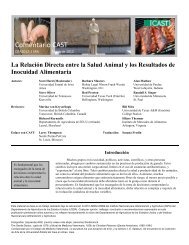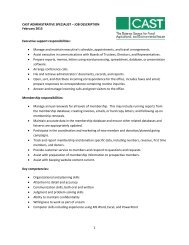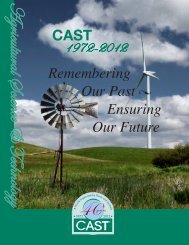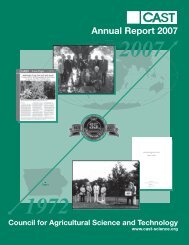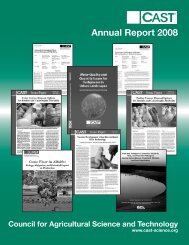Annual Report 2005 - Council for Agricultural Science and Technology
Annual Report 2005 - Council for Agricultural Science and Technology
Annual Report 2005 - Council for Agricultural Science and Technology
You also want an ePaper? Increase the reach of your titles
YUMPU automatically turns print PDFs into web optimized ePapers that Google loves.
Publications<br />
Global Risks of Infectious Animal Diseases, Issue<br />
Paper 28, February.<br />
Recent outbreaks of bovine spongi<strong>for</strong>m encephalopathy<br />
(mad cow disease), West Nile virus, foot-<strong>and</strong>-mouth<br />
disease in swine, <strong>and</strong> avian influenza have made headlines<br />
<strong>and</strong> are of concern not only <strong>for</strong> significant economic<br />
costs but also <strong>for</strong> the potential to “cross-over”<br />
to humans. This Issue Paper reviews the history <strong>and</strong><br />
outlines the potential impacts that such diseases will<br />
have throughout the world. Cochairs: James Pearson, International<br />
Consultant, Ames, Iowa; <strong>and</strong> M. D. Salman,<br />
Colorado State University, Fort Collins.<br />
El riesgo de las enfermedades animales infecciosas,<br />
Issue Paper 28SPA.<br />
Spanish translation of Global Risks of Infectious Animal<br />
Diseases.<br />
<strong>Agricultural</strong> Ethics, Issue Paper 29, February.<br />
What exactly makes something “right” or “wrong”?<br />
And, in the agricultural–environmental arena, who<br />
makes those decisions; how are such determinations<br />
made; <strong>and</strong> how are research, policies, <strong>and</strong> other players<br />
affected? These <strong>and</strong> related questions increasingly<br />
impact agricultural research <strong>and</strong> policy directions <strong>and</strong><br />
provide the framework <strong>for</strong> this Issue Paper. Chair: Jeffrey<br />
Burkhardt, University of Florida, Gainesville.<br />
Adventitious Presence: Inadvertent Commingling <strong>and</strong><br />
Coexistence among Farming Methods, CAST Commentary<br />
QTA<strong>2005</strong>-1, July.<br />
Adventitious presence refers to the unintended commingling<br />
of trace amounts of one type of seed, or seed<br />
product, with another. Although this process can occur<br />
with conventionally bred crops, adventitious presence<br />
is more commonly regarded as the presence of genetically<br />
engineered seed <strong>and</strong> product in nongenetically<br />
modified material. This document provides a framework<br />
to discuss development of a science-based policy <strong>for</strong><br />
adventitious presence. Coauthors: Drew L. Kershen,<br />
University of Oklahoma; <strong>and</strong> Alan McHughen, University<br />
of Cali<strong>for</strong>nia, Riverside.<br />
Presencia adventicia: mezcla inadvertida y coexistencia<br />
entre métodos de cultivo, CAST Commentary<br />
QTA<strong>2005</strong>-1SPA.<br />
Spanish translation of Adventitious Presence: Inadvertent<br />
Commingling <strong>and</strong> Coexistence among Farming<br />
Methods.<br />
Metabolic Modifiers <strong>for</strong> Use in Animal Production,<br />
Issue Paper 30, July.<br />
Third in a nine-part series on “Animal Agricultureʼs<br />
<strong>2005</strong> Highlights<br />
Future through Biotechnology,” this paper examines<br />
metabolic modifiers—compounds that alter the physiology<br />
<strong>and</strong> metabolism of animals in specific ways to<br />
improve efficiency of meat <strong>and</strong> milk production, <strong>and</strong><br />
in certain instances, to improve yield <strong>and</strong> composition<br />
of animal-derived products—<strong>and</strong> describes the classification,<br />
characteristics, effects, <strong>and</strong> status of approval<br />
worldwide. Cochairs: Donald H. Beermann, University<br />
of Nebraska, Lincoln; <strong>and</strong> Frank Dunshee, Department<br />
of Primary Industries, Werribee, Victoria, Australia.<br />
Crop Biotechnology <strong>and</strong> the Future of Food: A Scientific<br />
Assessment, CAST Commentary QTA<strong>2005</strong>-2,<br />
October.<br />
Transgenic varieties of crops have been consumed by<br />
humans <strong>and</strong> animals in most countries, so a prodigious<br />
amount of data <strong>and</strong> observation is available to judge<br />
their safety <strong>and</strong> usefulness. This Commentary weighs<br />
hypothetical hazards voiced by activist critics against<br />
available scientific experience with transgenic crops.<br />
Coauthors: Bruce M. Chassy, University of Illinois,<br />
Urbana; Wayne A. Parrott, University of Georgia; <strong>and</strong><br />
Richard Roush, University of Cali<strong>for</strong>nia, Davis.<br />
La biotecnología de los cultivos y el futuro de los alimentos:<br />
una contribución científica, CAST Commentary<br />
QTA<strong>2005</strong>-2SPA, October.<br />
Spanish translation of Crop Biotechnology <strong>and</strong> the Future<br />
of Food: A Scientific Assessment.<br />
NewsCAST Newsletter Vol. 32, No. 1—Spring/Summer<br />
<strong>2005</strong><br />
NewsCAST Newsletter Vol. 32, No. 2—Autumn/Winter<br />
<strong>2005</strong><br />
2004 <strong>Annual</strong> <strong>Report</strong>, Published September <strong>2005</strong><br />
Publications Catalog, Updated November <strong>2005</strong><br />
Publications<br />
on the<br />
CAST website:<br />
www.cast-science.org<br />
Click on<br />
"Publications"<br />
Display of CAST<br />
publications at<br />
the Fall Board<br />
Meeting.<br />
www.cast-science.org<br />
<strong>Annual</strong> <strong>Report</strong> <strong>2005</strong> <strong>Council</strong> <strong>for</strong> <strong>Agricultural</strong> <strong>Science</strong> <strong>and</strong> <strong>Technology</strong> 3



